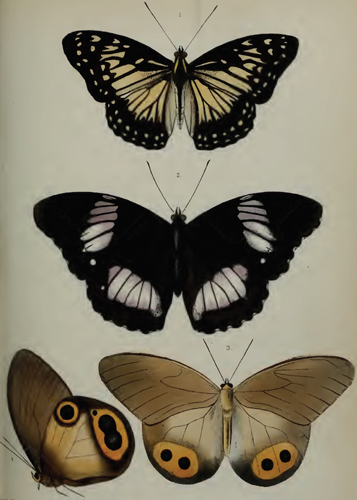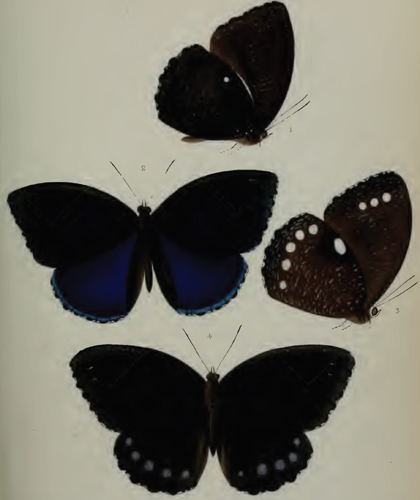3. DESCRIPTIONS OF SOME BUTTERFLIES FROM THE COLLECTION OF MR. WALLACE. BY W. C. HEWITSON.
(Plates VIII., IX.)
DIADEMA DIVONA. (Pl. VIII. fig. 1.)
Alis omnibus nigris, duplice serie submarginali macularum flavidarum, anticis ante medium fascia lata macularum oblongarum serieque macularum flavidarum, posticis basi ad medium flavidis, venis nigris.
Upperside, male: dark brown, rufous towards the anal angle of the posterior wing. Anterior wing with numerous bands and spots
P Z S. 1861 Plate VIII

1 DIADEMA DIVONA 2 DIADEMA DIOMEA
3 4 DRUSILLA DOMITILLA
P Z S 1861 Plate IX

1 2 MELANITIS MIMALON 3 4 MELANITIS LEUCOCYMA
of pale yellow. A line and two small spots within the cell; crossed before the middle by a broad macular band of irregular unconnected spots, the first two spots near the costal margin hastate (the second of them preceded by a small spot), the rest oblong (the last extending to the base of the wing), followed by a band of five spots; all yellow. Posterior wing with the basal half yellow, divided by broad black nervures. Both wings crossed by two submarginal bands of yellow spots—the first distinct and round, the second (near the margin) minute and linear; the margin also spotted with white.
Underside as above, except that the anterior wing has two white spots at the base of the costal margin, that the spots in the cell are larger (the linear spot occupying the whole base of the cell), and that the transverse band is broader and continuous; that the posterior wing has four white spots at the base, and the costal margin rufous.
Exp. 3½ inches.
Hab. Moluccas.
In the collections of A. R. Wallace and W. W. Saunders.
DIADEMA DIOMEA. (Pl. VIII. fig. 2.)
Alis omnibus nigris fasciis latis transversalibus liliaceo-albis, anticis macula alba anali, posticis serie submarginali macularum albarum.
Upperside, male: black. Both wings crossed transversely by a broad band of lilac-white, divided into six parts by the nervures, which are broad and black. Anterior wing with a distinct white spot near the anal angle, followed by three small indistinct spots. Posterior wing with four small white spots between the nervures, just beyond the central band, two of them near the apex, two near the anal angle; a submarginal band of white spots, in pairs. The outer margin of both wings spotted with white.
Underside as above, except that the anterior wing has the central band much broader, the costal margin near the base irrorated with white, and three small white spots within the cell; that the posterior wing has a white oval spot at the middle of the costal margin, the transverse band broader near the anal angle; and that both wings have two bunds of white spots near the outer margin: the first band, of triangular spots, in pairs; the second, nearer the margin, of lunular spots, scarcely seen at the apex of the anterior wing.
The female differs only in its greater size, and in having the transverse bands white.
Exp. 4 2/10 inches.
Hab. Moluccas.
In the collections of A. R. Wallace and W. W. Saunders.
DRUSILLA DOMITILLA. (Pl. VIII, figs. 3, 4.)
Alis omnibus supra rufo-fuscis, posticis basi pallidiore, macula mayna submarginali fulva, ocellis duobus nigris cœruleo-pu-pillatis ornata; subtus obscurioribus, posticis brunneis in medio albis ocello minuto (in exemplis[illeg] nonnullis) cœteris proximo alteroque magno apicali.
Upperside, male: pale rufous-brown. Posterior wing lighter near the base, the abdominal fold nearly white, the anal angle and outer
margin darker brown, with, near the middle of the outer margin, a large oval orange spot marked with two black ocelli, each with a centre of blue.
Underside as above, except that the bases of both wings, the abdominal fold, and the outer half of the posterior wing are dark brown; that the large orange spot is (in some examples only) extended towards the apex, so as to contain a minute ocellus; that the two ocelli are so enlarged as to meet in the middle; and that there is a large ocellus at the apex bordered with orange.
The female does not differ, except that it is much larger, with greater proportionate breadth of wing.
Exp. ♂ 3 7/10, ♀ 4 9/10 inches.
Hab. Batchian.
In the collections of A. R. Wallace and W. C. Hewitson.
This can scarcely be another variety of a most variable species. I fully believe that there is as yet but one other species of the genus Drusilla, and that all the butterflies hitherto described and figured, to which I have given references below, are only varieties of Drusilla urania.
I believe that D. horsfieldii of Swainson is simply a male variety of D. urania; that D. catops and D. selene of Boisduval's MS., described by Westwood in the Genera of Diurnal Lepidoptera, page 335=D. phorcas and D. mylœcha of Westwood in the Transactions of the Entomological Society, n. s. vol. iv. p. 182, pl. 21=D. myops and D. macrops of Dr. Felder in the Wiener Entom. Monatschrift, vol. iv. pp. 109, 248, and pl. 1=D. artemis, D. anableps, and D. dioptica of Vollenhoven in the Nederlandschc Entom. Vereeniging, are all referable to one species. They differ from each other (just as the butterflies do which I have figured, in a former Plate of these Proceedings, under the name of Melanitis melanc) in the position and quantity of the white on the surface, in the size and perfection of the ocelli, and their distance from the outer margin. Each genus seems to mimic the other in its general appearance, and each runs into the same extravagant varieties. If the butterflies which are enumerated above are to be considered as good species, there are several more in the collection of Mr. Wallace waiting for the same distinction. One lately arrived from Ceram has the whole underside of a uniform dark brown.
MELANITIS MIMALON. (Pl. IX. figs. 1, 2.)
Alis omnibus purpureis, marginibus griseis; subtus brunneis ubique griseo undulatis, posticis macula alba prope medium marginis costalis.
Upperside, male: purple, with a submarginal band of grey; the margins dentate and spotted with white.
Underside dark brown, undulated throughout with grey. Posterior wing with two minute spots near the base, a round spot near the middle of the costal margin, and some minute spots parallel to the outer margin, all white.
Exp. 3 3/10 inches.
Hab. Manado, Celebes.
In the collection of A. R. Wallace.
MELANITIS LEUCOCYMA. (Pl. IX. figs. 3, 4.)
Biblis leucocyma, Godart, Encl. p. 326.
Alis omnibus brunneis, marginibus griseis, anticis maculis duabus minutis prope apicem, posticis serie submarginali macularum liliaceo-albarum; subtus brunneis, ubique griseo-undulatis, posticis macula alba prope medium marginis costalis.
Upperside, male: dark brown, with a submarginal band of grey, the outer margins dentate and spotted with white. Anterior wing with two or three small white spots near the apex. Posterior wing with a submarginal band of five, round, lilac-white spots.
Underside rufous-brown, undulated throughout with grey, with a band of large white spots parallel to the outer margin; anterior wing with three or four; posterior wing with five. Posterior wing with an oval white spot near the middle of the costal margin.
Exp. 3½ inches.
Hab. Celebes.
In the collections of A.R. Wallace and W. C. Hewitson.
Dyctis agondas of Boisduval and Morpho bioculatus (Dyctis bioculatus of Westwood in the Genera of Diurnal Lepidoptera, pl. 54*, which is its female) belong to this genus, and do not differ in the least, in their generic character, from the other species of Melanitis. Deceived by its great variability and the wretched figure of D. agondas in the Voyage of the Astrolabe, I have figured, in a former Part of the Proceedings of the Zoological Society (Annulosa, Pl. LV.) a beautiful series of Butterflies from the collection of Mr. Wallace, under the name of Melanitis melane, which I now believe to be varieties of the said Dyctis agondas and D. bioculatus.
4. OBSERVATIONS ON THE ANATOMY OF THE ECHINODERMS. BY THOMAS HOWARD STEWART, M.R.C.S., F.Z.S., ASSISTANT CONSERVATOR, HUNTERIAN MUSEUM.
(Plates X., X. A, XI.)
There are certain points conneeted with the anatomy of the Echinoderms which I am anxious to lay before the Society; and the more especially do I desire to do so, as I am not able to find any true and accurate description existing of the very wonderful apparatus for the prehension and division of food, which some of the higher groups of this class possess. I mean higher groups with regard to the class itself. The animals forming this class, from their organization, are placed low in the scale of creation, being just above the Polypifera and below the Annelida; yet we shall find, in the order Echinoidea of this class, animals possessing what may be called a splanchnic or oral skeleton, of so complicated and yet so efficient an arrangement, as cannot fail to make us wonder at the object of its sudden appearance in the anatomy of animals; nor can we help admiring the beauty, and wondering at the perfection of the work. Those who have not searched into the anatomy of these lower forms of life might be surprised to be told that a creature just above the common Sea-anemone, with an almost invisible nervous system, and other-